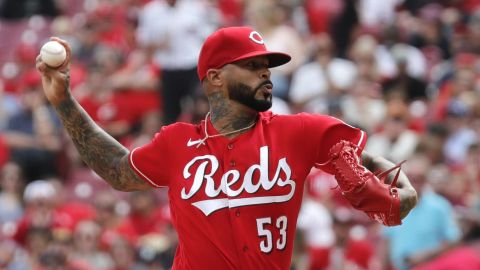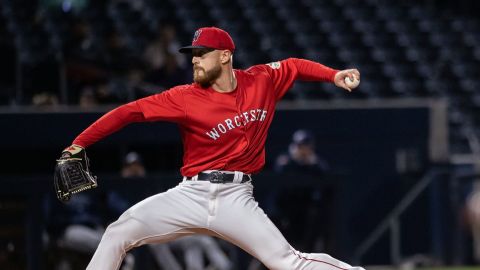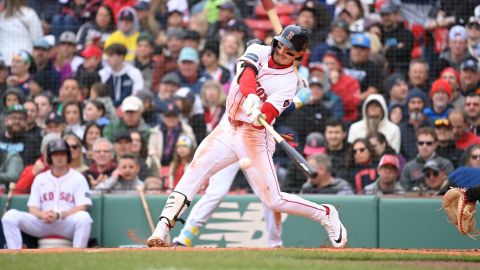 Now that we’re at the one-third mark of the Red Sox’ season, it’s OK to say it: 2012 was an aberration, and this year’s edition of the Boston ball club is absolutely for real. So, now that we’ve accepted that, the job of the scientist, sabermetrician or a plain objective observer is to explain why that is.
Now that we’re at the one-third mark of the Red Sox’ season, it’s OK to say it: 2012 was an aberration, and this year’s edition of the Boston ball club is absolutely for real. So, now that we’ve accepted that, the job of the scientist, sabermetrician or a plain objective observer is to explain why that is.
Thus far, there have been two primary narratives advanced on this subject by fans and the media alike. The first is that the pitching has been a lot better, and, truthfully, this probably accounts for at least 75 percent of the team’s turnaround from that terrible 2012 campaign.
The other narrative is improved clubhouse chemistry, with Bobby Valentine gone and a number of imported players known for their leadership and other intangibles now kicking around the Fenway Park home clubhouse. But while it’s true that guys like Jonny Gomes and Shane Victorino are known for their character, the team also let good guy Cody Ross walk, let occasional distraction Alfredo Aceves hang around, signed Stephen Drew and brought aboard John Farrell.
This isn’t a knock against Drew or Farrell, who are both professional and competitive. However, Farrell was perceived to have lost the clubhouse in Toronto last season, while Drew is known to have the same low-key personality as his brother, which didn’t sit all that well with Boston fans the first time around.
The point is that exulting or blaming intangibles like clubhouse chemistry and character is often a misnomer. Different players — even managers and coaches — can succeed under different circumstances, and “chemistry” is a product of playing winning baseball — absolutely not the other way around.
So, having left the rah-rah arguments, to pose the question again: Why are the Red Sox better this year? The answer is that, on the offensive end, the team recommitted itself to the organizational approach that made it successful in the first place.
It’s been oft-noted that under former general manager Theo Epstein, the Red Sox committed to a sabermetric approach to player evaluation, bringing in guys like Bill James and a number of other lesser-known number crunchers. However, for all the complicated data and dense algorithms that have followed sabermetrics, the foremost nugget of wisdom it has provided can be distilled into once sentence.
Getting on base is the most important thing to do in order to score runs.
Ultimately, pitching probably trumps everything else, but, on the offensive end of the game, there is no more important facet than getting on base. Teams who put runners on and control counts win baseball games. It’s as simple as that.
So, looking at the Red Sox’ offensive numbers as compared to last season’s, it’s not difficult to see why the team has been so successful.
The Red Sox entered Wednesday having scored the second-most runs in baseball, just three behind the Tigers and tied with the Orioles. Likewise, the team has taken 210 walks this year, which is also second in baseball. (Detroit is fourth, while Baltimore, somehow, is 18th.)
That’s an impressive turnaround for a Red Sox team that walked just 428 times last season, which was the second-worst rate in baseball. Basically, we’re one-third through the MLB season, but Boston already has almost half as many walks as it did all of last year.
Beyond the walks, patience is part of a two-pronged strategy for the offensive attack. Obviously getting baserunners on is great, but there’s also a big value to seeing extra pitches and making a pitcher work. It can’t exactly be quantified, but it’s conventional wisdom that pitchers who have to grind for outs make more mistakes, and the Red Sox have absolutely been grinding out at-bats. As of May 23, Boston led the league in pitches seen per at-bat, with an average of 4.08.
Mike Napoli, in particular, has shown exactly why the Red Sox brought him aboard. Though his early-season hot streak was never going to become a season-long trend, based on what he’s done throughout his career, his patience at the plate makes him valuable even when he’s not hitting. In fact, as of a week ago, Napoli was leading baseball with 4.51 pitches seen per at-bat.
Of course, this is all by design — general manager BenCherington‘s design, in fact. While Dustin Pedroia, Daniel Nava and Jacoby Ellsbury lead the team in walks, the next three on the list are players brought in over the offseason — Napoli (who’s tied with Ellsbury), Drew and Gomes. In fact, Drew and Gomes’ walk numbers are even more impressive when you consider that Drew missed almost two weeks’ worth of games with a concussion, and Gomes has seen infrequent time in the field with Nava playing so well.
Each of these three players was brought in specifically to raise the team’s OBP, and it’s absolutely worked so far. Gomes may only be hitting .168, but he’s also walked 20 times. Napoli and Drew, meanwhile, have isolated OBPs of .080 and .100, which are very impressive.
In short, player performance can fluctuate year-to-year and week-to-week based on a number of factors. A good batting eye, however, is something that isn’t at the whim of injury or a slump and is perhaps the most important part in determining a hitter’s value.
With players like David Ortiz, Kevin Youkilis, J.D. Drew and Kevin Millar — players who always got on base far more frequently than their batting averages might suggest — the Red Sox’ championship seasons were teams built on patience and taking walks. After getting away from that strategy for a couple years (as good as Carl Crawford was before he came to Boston, he only had a .337 career OBP to that point), the Red Sox have gotten back to it, and it has paid huge dividends.



